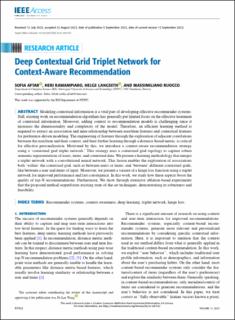| dc.description.abstract | Modeling contextual information is a vital part of developing effective recommender systems. Still, existing work on recommendation algorithms has generally put limited focus on the effective treatment of contextual information. Moreover, adding context to recommendation models is challenging since it increases the dimensionality and complexity of the model. Therefore, an efficient learning method is required to extract an association and inter-relationship between user/item features and contextual features for preference-driven modeling. The engineering of features through the exploration of adjacent correlations between the user/item and their context, and their further learning through a distance-based metric, is critical for effective personalization. Motivated by this, we introduce a context-aware recommendation strategy using a ‘contextual grid triplet network.’ This strategy uses a contextual grid topology to capture robust semantic representations of users, items, and contextual data. We present a learning methodology that merges a triplet network with a convolutional neural network. This fusion enables the exploration of associations both ‘within’ the contextual grid, such as between users or items, and ‘between’ different contextual grids, like between a user and items of input. Moreover, we present a variant of a hinge loss function using a triplet network for improved performance and fast convergence. In this work, we study how these aspects boost the quality of top-N recommendations. Furthermore, We show through extensive ablation-based experiments that the proposed method outperforms existing state-of-the-art techniques, demonstrating its robustness and feasibility. | en_US |

